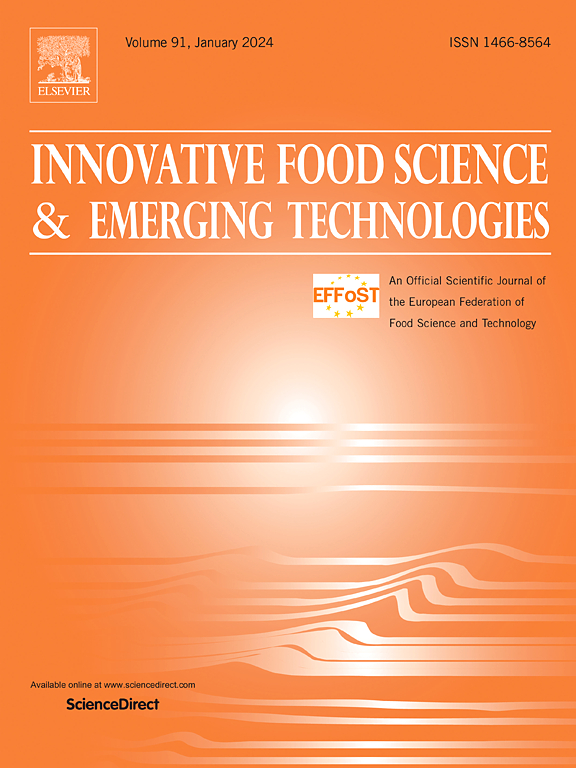Numeric and machine learning modeling of mass transfer in radish brining with pulsed electric field and plasma-activated water pretreatments
IF 6.3
1区 农林科学
Q1 FOOD SCIENCE & TECHNOLOGY
Innovative Food Science & Emerging Technologies
Pub Date : 2025-07-19
DOI:10.1016/j.ifset.2025.104122
引用次数: 0
Abstract
Brining requires a high NaCl concentration and long duration, complicating quality management and necessitating accurate prediction models. This study explores the synergistic effects of low-intensity pulsed electric field (PEF) and plasma-activated water (PAW) pretreatments on radish brining in 5 % and 10 % NaCl solutions, predicting mass transfer using numeric and machine learning models while evaluating microstructural changes by the pretreatments. The combined PEF (0.2–0.4 kV/cm) and PAW (oxidation-reduction potential: 496–531 mV) pretreatment reduced the brining rate by up to 42 % compared the rate obtained without the treatment during the initial stage of brining. This effect was attributed to enhanced cell permeability, as evidenced by increased electrical conductivity and Z-index. The Ensemble model, a machine learning model, provided competitive prediction on the moisture loss and NaCl uptake rate compared to numeric models, with a root mean square error of 0.04 for moisture loss and 0.01 for NaCl uptake, and a higher R2 (0.99 for moisture loss, 0.99 for NaCl uptake). PEF and PAW individually enhanced moisture loss (up to 43.81 %) and NaCl uptake (up to 8.17 %), with combined treatments showing synergistic effects, particularly at 10 % NaCl due to greater osmotic gradients. The combined application of PEF and PAW pretreatments increased the hardness and decreased the cutting force of radish. These findings suggest that PEF and PAW pretreatments enhance mass transfer efficiency in the brining process and the process can be adequately predicted using the machine learning model.
脉冲电场和等离子体活化水预处理萝卜盐水传质过程的数值和机器学习建模
盐渍需要较高的NaCl浓度和较长的时间,使质量管理复杂化,需要精确的预测模型。本研究探讨了低强度脉冲电场(PEF)和等离子体活化水(PAW)预处理在5%和10% NaCl溶液中对萝卜卤化的协同效应,利用数值和机器学习模型预测传质,同时评估预处理对萝卜微观结构的影响。PEF (0.2-0.4 kV/cm)和PAW(氧化还原电位:496-531 mV)联合预处理与未处理相比,在盐水初始阶段的卤化率降低了42%。这种效果归因于细胞渗透性的增强,电导率和z指数的增加证明了这一点。与数值模型相比,机器学习模型Ensemble模型提供了具有竞争力的水分损失率和NaCl吸收率预测,水分损失率和NaCl吸收率的均方根误差分别为0.04和0.01,R2更高(水分损失率和NaCl吸收率分别为0.99和0.99)。PEF和PAW分别提高了水分损失率(高达43.81%)和NaCl吸收量(高达8.17%),联合处理表现出协同效应,特别是在NaCl含量为10%时,由于渗透梯度较大。PEF和PAW复合预处理提高了萝卜的硬度,降低了萝卜的切削力。这些结果表明,PEF和PAW预处理提高了盐水过程的传质效率,并且可以使用机器学习模型充分预测该过程。
本文章由计算机程序翻译,如有差异,请以英文原文为准。
求助全文
约1分钟内获得全文
求助全文
来源期刊
CiteScore
12.00
自引率
6.10%
发文量
259
审稿时长
25 days
期刊介绍:
Innovative Food Science and Emerging Technologies (IFSET) aims to provide the highest quality original contributions and few, mainly upon invitation, reviews on and highly innovative developments in food science and emerging food process technologies. The significance of the results either for the science community or for industrial R&D groups must be specified. Papers submitted must be of highest scientific quality and only those advancing current scientific knowledge and understanding or with technical relevance will be considered.

 求助内容:
求助内容: 应助结果提醒方式:
应助结果提醒方式:


